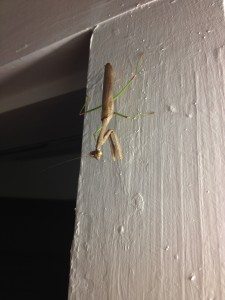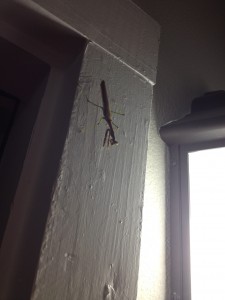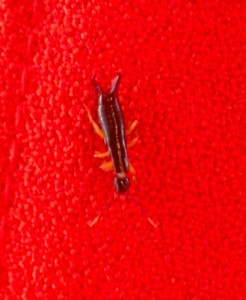It was roughly 9:30pm, and I had just arrived to my apartment on a Tuesday night after cheer practice. I approached my apartment door, and as I was turning my key I happened to look up to the right of my door where the outdoor lamp was shining, exposing two large eyes that were staring right back at me. I paused for a second, and analyzed the slender stick-like body with the long green legs extending onto the surface. When I easily spotted the praying structures I knew right away that I had found me a Mantis.
I quickly opened the door and had my roommate fetch me a plastic tupperware so that I could catch him for lab. He stayed completely still until I edged him on to walk into my plastic trap. I made sure to get some decent photos before I stuck him inside the container.
Both photos taken by Alyssa Thomas (me)
Mantises are commonly called “Praying Mantis” because of their raptorial forelegs, which have a prayer structure. The common name is ironic in a way because these “praying structures” actually help these insects prey on smaller insects. Mantises are in the order Mantodea and there are over 2,400 species with most of them coming from the Mantidae family.
As mentioned before, mantises prefer to eat smaller insects such as mosquitoes, crickets, and moths. They patiently wait for their prey and then extend their forelegs, which have sharp spines to get a good grasp. Then the mantis will viciously bite into the neck, paralyzing the prey to make finishing off their meal a lot easier.
The interesting thing about these insects is that they are not picky eaters. Females will sometimes eat their own offspring after the eggs hatch. They even participate in sexual cannibalism, which consists of the female devouring the male’s head after he delivers his sperm. Click here to see a video of a hungry female mantis!
As you could see these mantises have an appetite, and they will do anything to fulfill it. One of the most recent found discoveries in the orchid mantis is the insect’s ability to mimic a flower to attract prey. This article describes the research done by scientists of Macquire University in Australia and of the University of Auckland in New Zealand.
The scientists gathered orchid mantises from the forests in Malaysia while also collecting general flowers for their experiment. They performed two experiments to research this bizarre ability that orchid mantises seem to have!
The first experiment was done to compare the color of orchid mantises to native flowers to see if these insects are capable of looking like these colorful Malaysian flowers in the first place. They used a spectrophotometer to measure the wavelengths of native Malaysian flowers. Pollinating insects (a.k.a mantises prey) are unable to distinguish the color of orchid mantises from various Malaysian flower species.
Photograph by Thomas Marent, Minden pictures/Corbis in Borneo, Malaysia.
This definitely helps trick insects so that these orchid mantises can eat!
The second experiment was even more interesting. They counted the number of insects attracted to native flowers and those attracted to the orchid mantis flower by observing them in the field. The researchers found that more insects were attracted the deceiving mantis flower instead of the actual native flower!
So these orchid mantises give a great example of one way these mantises patiently capture their lovely, insect meal!





